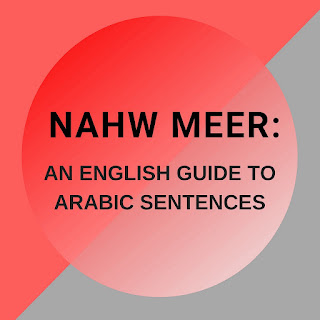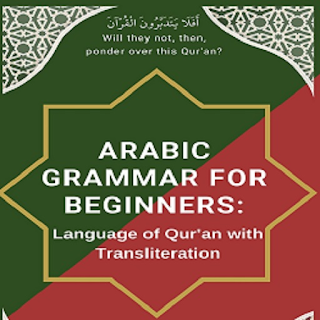Sarf and Nahw Summary: 1.2 - Arabic Words (كَلِمَة)
Section 1.2 - Arabic words (كَلِمَة)
All Arabic words (كَلِمة) are made up with meaning in two ways:
1) A Single word (مُفْرَد)
2) A Compound word (مُرَكَّب).
A single word is called (كَلِمَةٌ) or speech. Single words can only be one of the three:
1) Noun اِسْمٌ
2) Verb فِعْلٌ
3) Particle حَرْف
Compounds:
A Compound is a part of a sentence or speech (جُمْلَة): These are four commonly used categories:
1) Descriptive Compound اَلْمُرَكّبُ التَّوْصِيْفِيْ: This comes from an adjective (description) called صِفْةcombined with the described مَوْصُوْف like saying “big book كِتابٌ كَبِيْرٌ”. Good is the صِفْةand book is مَوْصُوْف.
2) Demonstrative compound اَلْمُرَكّبُ الْإشَارِي: This is a compound used to point at things like saying: “This is a book هٰذَا كِتاَبٌ”
3) Genitive Compound اَلْمُرَكَّبُ الْجاري: This compound is made with prepositions to create the meaning of words like “for, in, among” as in مِنْهُمْmeaning “among them” in which min is the preposition and hum is the noun/preposition which is always majroor.
4) Possessive Compound الْمُرَكّبُ الْإِضَافِيْ: Since Arabic has no word like “of” to show the relationship of ownership such as Zaid’s book, this compound is used كِتابُ زَيْدٍ where كِتَاب is called possessed (مُضَاف) and Zaid is the possessor (مُضَاف إلَيْهِ).
In addition, you can also make مُرَكَّبُ الْعَطْفِيْ
Conjunctive compound such as لَعِبٌ وَلَهْوٌ, الْمُرَكَّبُ الْبِنائِي structural compound such asأحْدَ عَشْرَ , and مُرَكَّبُ الْمَنْعِ الصَّرْفِيْ such as حَضْرَ مَوْتُ.
In Arabic, a noun can have only three states (إعْرَاب). These are Nominative (رَفْع), Accusative (نَصْب) or Genitive (جَرّ). Normally dammah is used for Nominative, Fathah for Accusative, and Kasrah for Genitive. These harakahs are not necessarily flexible (إعْرَاب). A noun can go into any of the three states and not have these harakahs associated with it and it depends upon its position in the sentence and construction.
Similar to Nouns, Verbs also have three states. These are Indicative (مَرْفوْع), Subjunctive (مَنْصُوْب) and Jussive (مَجْزُوْم). Examples would be:
يَفْعَلُ Indicative مَرْفوُع
يَفْعَلَ Subjunctive مَنْصُوْب
يَفْعَلْ Jussive مَجْزُوْم
Sentences:
There are two types of sentences in Arabic. These are Nominal sentence جُملَة اِسْمِية and Verbal sentence جُمْلَة فِعْليَة.
The nominal sentence has two parts in it. The first part is called the Beginning noun or الْمُبْتَدأ and second part is called a predicate or الْخَبْر. These can be single nouns, compounds, or sentences. An example sentence would beهُوَ اللّٰهُ meaning “He is Allah”. Here هُوَ is the beginning noun الْمُبْتَدأ and اللهُ is the predicate الْخَبْر or زَيْدٌ عَالِمٌ meaning “Zaid is an Alim”. Zaid is the Beginning noun and Alim is its predicate.
Both are almost always Nominative. Beginning noun is always a definite noun مَعْرِفَة, and it can only be an indefinite نَكِرَة if there is a negative particle in front of it as in فَلَا خَوفٌ عَليْهِمْ meaning “there will be no fear for them”. Here فَلَا خَوفٌ is appropriate to be called a mubtada, even though خَوفٌis indefinite.
The order is sometimes changed to create different meanings such as emphasis. These are called succeeding Beginning noun الْمُبْتَدأ مُوَخَّر and preceding predicate الْخَبْر مٌقَدَّم.
A verbal sentence جُمْلَة فِعْلِيَة has a minimum of two parts in Arabic. The first part is the verb فِعْل itself and second is the actor فَاعِل which is a noun, a compound, or a sentence. After that, several other nouns are used to explain the reason for the action, the object on which action is happening, the time and place, etc. These are called Objects مَفْعُوْل. The proper order is Verb first, Actor next, and Object is third.
For example, ضَرَبَ زَيْدٌ حَامِدًا which means “Zaid Hit Hamid”. ضَرَبَis the verb, the actor فَاعِل isزَيْدٌ explicit because it is Nominative and present, حَامِدًاis object مَفْعُوْل since it is Accusative.
When you come across a Verb, look for a single noun which is Nominative with Dammah on it, then it is most likely to be the actor فَاعِل and it will be called an explicit actor (remember that this actor could also be a compound or even a sentence). The construction of a verb tells you if the actor is in it or not. If you do not find this single noun, then either actor is hidden pronoun ضَمِيْر مُسْتَتِر or an attached pronoun ضَمِيْر مُتَّصِل is acting as an actor and it is called Visible pronoun ضمير بَارِز.
For example, look at the sentence:
هَلْ يَسْتَوِي الْأَعْمٰى وَالْبَصِيرُ
Are they equal, the blind and the seeing?
Here هَلْ is an interrogative particle. يَسْتَوِيis Imperfect verb made from root words س و ي with form إفْتِعَال. So the Perfect verb is اِسْتَوَاء and Imperfect verb is يَستَوِيْwhich means “they are equal”. In this sentence, الْأَعْمٰى وَالْبَصِيرُ meaning “blind and the one with vision” is the explicit actor.
If we take the example خَلَقَ السَّمَاوَاتِ, the Verb خَلَقَhas a hidden pronoun هُوَ which means He created. السَّمَاوَاتِwould be the object of the verb مَفْعُول بِهِ which answers the question what did He create? He created the Heavens السَّمَاوَاتِ.
If we modify the sentence a bit and say خَلَقَ اللهُ السَّمَاوَاتِ, now اللهُbecame the explicit actor. Now the sentence would mean Allah created the Heavens.
If you see a dammah, it is likely a Nominative noun but sometimes it can be Accusative نصْب or Genitive جَرّ and if it gives the meaning of an actor, it would be called مَرْفُوْع مَحَلًاor Nominative by position.
Another example for positional ‘Eraab (flexibility) is the word meaning ‘لَهُmeaning “for him). The “haa” has a Dammah but it is considered to be Genitive because it is after a Preposition, then it is called Genitive by position مَجْرُوْر مَحَلًا.
Similarly, a Fathah is likely an Accusative نَصْب and a Kasrah is Genitive جَرّbut like before, in some cases they can be a different state by position. All objects مَفْعُوْل are always in Accusative نَصْب.
For verb like particle مُشِبْهَةُ بِالْفِعْل (which are Inna and its sisters) and incomplete verbs فِعْل نَاقِص (which are Kana and its sisters), the sentences made with them are the nominative sentences. The Nominative noun after these is called a noun اِسْمif kana is used, and predicate الْخَبْر if Inna is used. If the noun is Accusative نَصْب, then it is Predicate if Kana is used and Noun اِسْم if Inna is used. Note the use of Nominative and Accusative is reversed between kana and Inna. These two form a Nominal sentence جُملة اِسْمِيَة and not a verbal sentence جُمْلَة فِعْلية.
۞۞۞





Comments